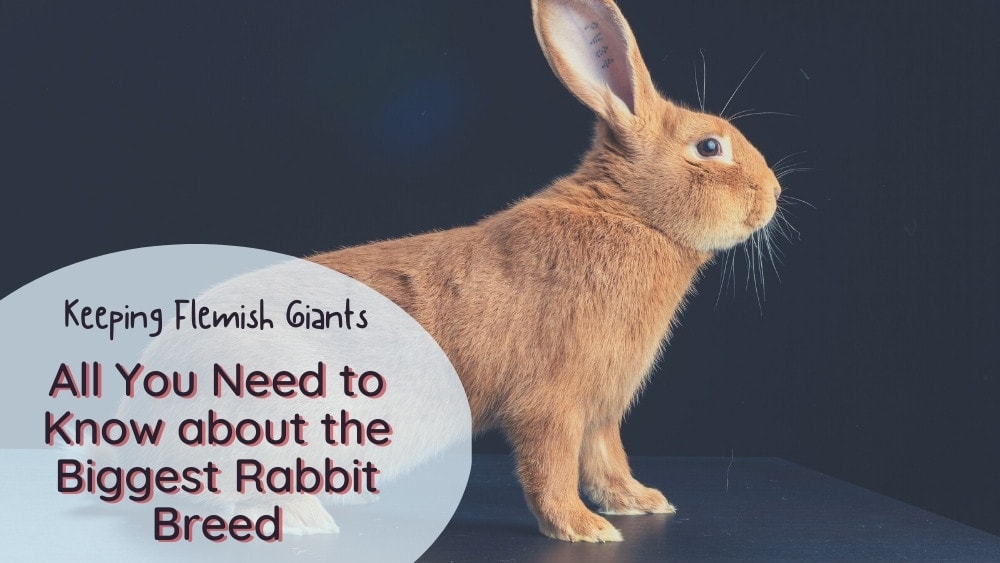If there was a sitcom about pet owners, it would be a running joke. She wants a dog; he doesn’t. He agrees to a rabbit. She walks in with a bunny the size of a terrier.
It’s a Flemish Giant.
Have you seen pictures of these enormous rabbits? Are you wondering just how big Flemish Giants can get? In this article, we’ll cover all you need to know about the biggest bunny breed before welcoming one into your family!
What is a Flemish Giant Rabbit?
Flemish Giants are the gentle giants of the rabbit kingdom. These mammoth bunnies have large, blocky heads, heavy jowls, and big bell-shaped ears. They have soft, luscious fur coats and usually docile personalities. Weighing an average of 15-22 pounds as adults, they measure at least 20 inches from nose to tail.
Breed Characteristics at a Glance
| Body Type: | Semi-Arch |
| Size Category: | Giant |
| Adult Weight: | 15-20+ pounds (6.8 – 9 kg) |
| Colors: | Black, Blue, Fawn, Light Gray, Steel Gray, Sandy, White |
| Coat Type: | Rollback |
| Country of Origin: | Belgium |
| Countries Where Found: | Worldwide |
| Conservation Status: | Not Threatened |
| Temperament: | Docile |
| Special Needs: | Solid floors, extra space, careful handling. |
How Big will a Flemish Giant Rabbit Get?
Although there are images circulating the web of giant rabbits that look almost as large as their owners, these are usually optical illusions. While any Flemish Giant is an armful, they usually top out at 18-20 pounds. There are reports of Flemish growing up to 30 pounds.
It would be fun to brag about owning the biggest bunny on the block, but we caution against using size as the main criterion for choosing your bunny. Steer clear of a breeder that selects mating pairs based only on size, as they may neglect other critical traits, such as personality and general wellness.
Whether your Flemish Giant is on the larger or smaller end of the giant bunny spectrum, it will still be big enough to amaze your friends.
How Long is a Flemish Giant Rabbit?
The standards of the American Rabbit Breeders Association, used by breeders that show their Flemish Giants, state that adult Flemish must be no less than 20 inches in length from the tip of the nose to the base of the tail. Their ears must be a minimum of 5 ¾” in length.
The largest Flemish Giant recorded by the Guinness Book of World Records was Darius, who measured 4 ft 3 in (129 cm) in length.
At What Age is a Flemish Giant Full-Grown?
Flemish Giants are considered adults at 8-12 months of age. However, they may continue to grow and reach their peak size at 15-18 months of age.
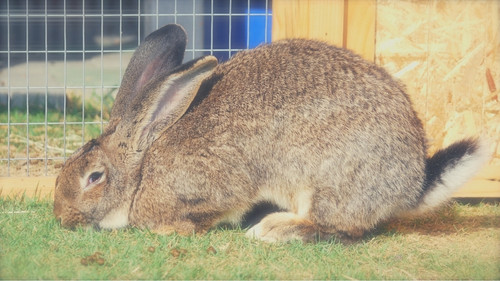
Of course, if you feed your bunny too much it will continue to gain weight, no matter what age it is. This is not healthy. Once your Flemish Giant is an adult, you should ration its daily pellets to prevent obesity.
What Colors Can They Be?
In the United States, Flemish Giants are recognized in six colors: black, blue, fawn, light gray, steel gray, sandy, and white.
The “blue” color is a light gray. “Fawn” is a soft golden color. “Light gray” looks like the coat of a chinchilla rodent. The “white” variety in this breed has red eyes.
The “Sandy” color in Flemish Giants is known as “chestnut” in other breeds of rabbits and has the same basic genotype as the wild rabbit color.
Sandy is the original rabbit color and other color varieties in this breed are mutations from it.
Flemish Giant Breed History
According to Domestic Rabbits and their Histories, by Bob Whitman, Belgium is the home of this giant bunny. It’s unclear when exactly the breed emerged, but there are reports from Italy in 1558 of “rabbits four times bigger than normal.” It seems the breed was circulating in Europe by the 16th century.
We know for sure that English rabbit clubs had recognized and were showing this gentle giant by the 1850s.
In 1867, British fanciers awarded a “biggest rabbit” prize to a Flemish Giant doe that weighed 19 pounds (8.5 kg), a new record weight.
Flemish Giants were imported to the US in the early 1900s when fancy rabbits were booming in popularity.
Flemish Giant vs Continental Giant: What’s the Difference?
The Flemish Giant and Continental Giant are both scale-tipping rabbit breeds. The Continental Giant is descended from the Flemish, so they share a lot of genetic makeup. Both of the breeds have wide-set faces, long hefty bodies, and thick, strong feet.
Both breeds are recognized by the British Rabbit Council standards and are raised across Europe. (In some countries, the Continental Giant is called the German Giant.) The Continental Giant is not recognized by the American Rabbit Breeders Association, though there are a few American breeders that keep them for fun.
The differences between the two breeds are subtle. In the British Rabbit Council standards, the Continental Giant is required to be just a little bigger, but neither breed has a maximum weight or size. They have slightly different body shapes and color requirements. But either breed can make a wonderful friendly pet.
Conservation Status
The American Livestock Breeds Conservancy (ALBC) recognizes breeds of bunnies that are in danger of extinction, but the Flemish Giant is not on the list. This old breed of rabbit has been carried across the globe for more than a century.
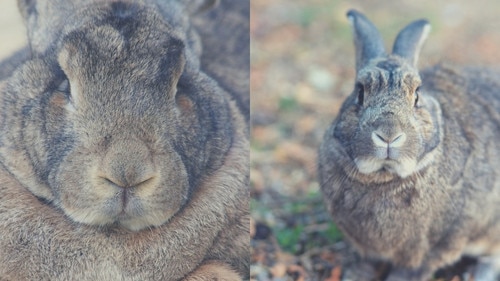
You can find Flemish Giants in Europe, Australia, China, Japan, Singapore, Canada, and every state in the US.
Flemish Giant Personality and Temperament
Flemish Giants have chill, laid-back personalities. They are calm and patient rabbits that generally take life as it comes. Flemish Giants are less likely to be stressed by change or noise than smaller, more energetic breeds. They settle into their new environments quickly.
But that doesn’t mean they aren’t playful! Each Flemish Giant has his or her own preferences. Some want to be snuggled and petted. Others will have a silly side. There are, of course, a few that will be skittish, cranky, or uptight. These usually haven’t socialized with humans much and will settle down over time as they recognize your gestures of friendship.
Do Flemish Giant Rabbits Make Good Pets for Kids?
Flemish Giants’ personalities make these rabbits great pets if you have the right setup for them.
As we’ll discuss below, these rabbits need careful handling and lots of space to exercise. Cleaning up after them is more work than cleaning up after a smaller breed.
While some kids do keep and show Flemish Giant rabbits in 4-H shows and county fairs, this breed can be difficult even for adults to handle!
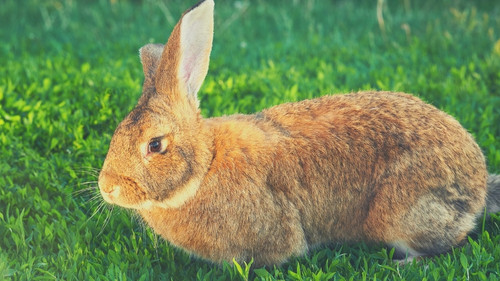
A child may be able to lift an adult Flemish, but won’t be able to hold it for long! If the bunny struggles and is dropped, the rabbit may be injured, the child will likely be scratched, and there will be tears all around.
The Flemish Giant is best kept as a family pet, with adults in the family sharing the caretaking responsibilities and overseeing the children’s time spent with the bunny.
How long do giant Flemish rabbits live?
Flemish Giants kept indoors live an average of 5-7 years. This is slightly shorter than an average rabbit’s lifespan.
Rabbit breeds that were developed for one particular trait – in this case, size – sometimes have shorter lifespans than crossbred rabbits. Sometimes, sadly, breeders sacrifice general health at the altar of their desired goal.
Due to a Flemish Giant’s size and weight, it is prone to injury like a foot fracture. Female Flemish, like all other breeds of rabbits, are prone to develop uterine cancer if left intact.
However, if you get your Flemish neutered, handle it gently, provide an ideal environment, and take it for regular veterinary checks, it may live 8 years or more.
Flemish Giant Housing
These huge bunnies have different housing needs than normal-sized breeds. While it’s common for many rabbit breeds to be kept in a cage with wire floors, this is absolutely not an option for Flemish Giants.
Flemish Giants should never be kept in a cage with a wire floor.
There are a few reasons why I caution so strongly against this:
- Flemish Giants are prone to developing sore hocks. This condition, known technically as pododermatitis, occurs when the fur wears away on the bottom of the rabbits’ hind feet and the skin becomes blistered and infected. Sore hocks are very difficult to treat and wire floors are a prime culprit in causing this condition.
- Giant rabbits are also prone to femoral fractures – or broken legs.
- Wire cages don’t provide enough width for giant bunnies to get sufficient exercise or enough height for them to stand upright.
- And, to be blunt: Flemish Giant poop is too big to fit through the mesh of wire cage floors. This defeats the only benefit of keeping your rabbit on wire.
The best housing option for a Flemish Giant rabbit kept outdoors is a solid wood hutch raised off the ground, with an attached enclosure so that your bunny can get supervised outside playtime.
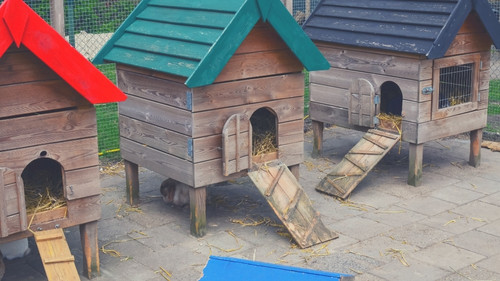
The best option for keeping a Flemish Giant inside the house is a dog playpen equipped with some castles or hiding holes and a litter box. You can let your rabbit have free range of all bunny-proofed areas of your house during the day, but it should be placed in its enclosure for safety at night and when you are gone.
An enclosure for a Flemish Giant should have a footprint of 12 square feet.
Can you potty train a Flemish giant rabbit?
Yes, absolutely! Flemish Giants are intelligent critters that love to be tidy. They will naturally choose a section of their enclosure to use as their potty spot. This makes litter training easy!
Our article on “how to litter train rabbits” has step-by-step instructions on how to help your rabbit adjust to the hygiene rules of the house.
Caring for Flemish Giant Rabbits
How hard is it to take care of a Flemish Giant rabbit?
Caring for a Flemish Giant is not much more difficult than taking care of other rabbit breeds. They do eat more – which means there’s more to clean up on the other end – but they only need to be given pellets twice a day like any other rabbit. Their litter boxes must be cleaned daily. However, they do not necessarily need daily grooming, since they don’t have wool coats.
Tasks that involve handling your rabbit, such as trimming nails and doing a routine health check, may be harder with a Flemish Giant until you get used to handling it.
The following sections will discuss feeding, grooming, and handling Flemish Giants in more detail. (And if you’re looking for a deep dive into rabbit care, be sure to check out our article Pet Rabbits 101.)
Feeding Flemish Giants
Flemish Giants, like other breeds of rabbits, need a diet that’s high in roughage and low in protein and fat. This means that 80-90% of your rabbit’s daily diet should be high-quality timothy hay.
The remainder of the diet should be rabbit-safe vegetables – like dark leafy lettuce, cilantro, or bell pepper – and a small helping of fortified rabbit pellets to ensure a balance of nutrients.
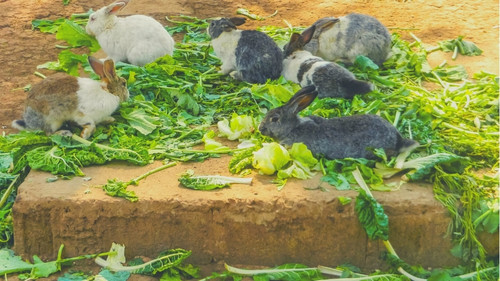
If you have a free-ranging Flemish Giant, he may learn to beg at the table like a puppy. But try to resist feeding him from your plate! Like kids, rabbits will turn up their noses at cooked vegetables, but they will happily share your dessert, no matter how bad it is for them.
Cookies, crackers, cereal, and other human treats can be deadly for rabbits.
How much do Flemish Giants eat?
Many pet owners feed their rabbits only or primarily pellets. Most rabbit foods are advertised as “balanced” rations, which means the rabbit can survive on nothing but commercial pellets.
So if your Flemish Giant ate nothing but pellets, it would eat about 2 oz or ¼ cup of pellets per day per 5 pounds of body weight. This means a 15-pound rabbit would eat 6 oz or ¾ of pellets per day.
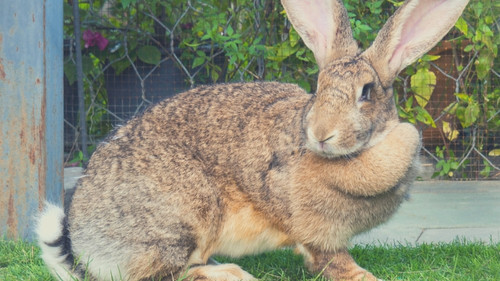
However, many commercial feeds contain filler ingredients like soybean hulls or wheat middlings, which add roughage without any nutritional value. The manufacturers then add synthetic nutrients back into the pellets to make up the difference.
This is why we recommend against feeding your rabbit only pellets. Instead, offer your Flemish Giant as much clean hay as it can eat all day long. Give it a full cup of dark green vegetables and ⅛ to ¼ cup of pellets in the morning and evening.
If you find your rabbit is becoming underweight, you can increase the amount of pellets.
Grooming Flemish Giants
This bunny breed looks like a huge stuffed animal. While super fluffy and soft, Flemish technically have short coats, meaning that they don’t have wool like an angora. However, their fur is on the longer side of “short,” at about 1 and ½” in length. And they have a lot of it.
So when your Flemish Giant starts to shed, you’ll definitely want to bust out the vacuum for your living room!
Do Flemish Giants Shed a Lot?
Flemish Giants go through a complete change of coat, called a molt, once or twice a year. During this time, use a slicker brush on your bunny daily. Remove as much of the dead hair as you can to help prevent hairballs in your rabbit’s stomach, which can be deadly.
Grooming your Flemish once or twice a week is often enough when it’s not molting. Flemish need their nails trimmed every 4-6 weeks.
Should you Give your Flemish Giant a Bath?
Large breeds like Flemish may get dirty tails and “poopy butts” more often than other breeds of rabbits. However, you should almost never give your rabbit a full bath.
Baths can be a shock to rabbits of any size and damage the integrity of their fur. It’s better to spot-clean your rabbit or give it a bum bath when necessary.
Flemish Giant Health Concerns
Flemish Giants are generally healthy rabbits. There are no major health concerns that plague this breed, like there are with dwarf breed bunnies. However, due to their ungainly size, they are prone to a few medical issues:
- Obesity. Flemish Giants have slower metabolisms than small, energetic rabbits. But people tend to overfeed them thinking that a giant bunny needs constant access to pellets.
- Fractured or dislocated joints. This can happen on the front or hind legs, but is most common on the rear leg at the hock or elbow joint.
- Sore hocks. As mentioned above, the weight a Flemish bears on the hock joint can cause the fur and skin to break down if the rabbit is kept on a rough surface, causing painful sores.
- Boredom and depression. Owners often underestimate the amount of space a Flemish needs to exercise and the amount of time out of the cage that’s required for a rabbit’s mental health.
Can you Pick Up a Flemish Giant?
We recommend against picking up your Flemish Giant except when you really have to. In most rabbits, being picked up triggers their “fight or flight” response. They may kick or struggle, injuring both themselves and their handlers. Because even though Flemish have heavy bone structure relative to most rabbits, their bones are still delicate and may break if they’re dropped onto a hard surface.
That said, there are times when you will need to pick up your bunny. Perhaps you need to put it in a carrier to go to the vet, or quickly rescue it from the neighbor’s dog. You should practice handling your Flemish often enough that you can safely pick it up when you need to.
Never grab your bunny by the ears or the scruff of its neck. “Scruffing” a bunny can tear the skin on its bunny’s shoulders, especially on a very heavy rabbit. Instead, always pick your rabbit up from underneath. One hand supports your rabbit’s chest and the other should support its rump. Learn how to tuck the rabbit against your body for safety, and how to gently lower it into a box or carrier.
It’s extremely helpful to have a vet, breeder, or expert rabbit handler show you how to pick up your Flemish Giant without hurting your bunny or yourself.
How do you bond with a Flemish Giant rabbit?
Bonding with your pet Flemish Giant is a similar process to bonding with any other rabbit. Playtime with a bunny should happen on the floor, down on your rabbit’s level on a safe and non-slip surface. Hold a treat in your hand and let your bunny approach you when it is ready.
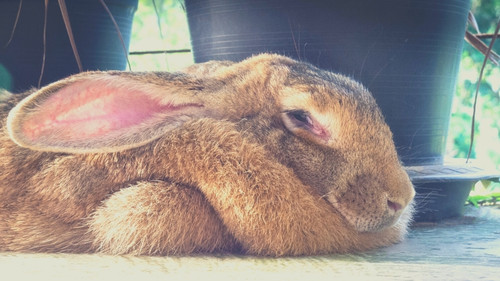
As you learn your rabbit’s preferences, you may find that some prefer to play chasing games while others just want their ears rubbed. As your rabbit warms up to you, it’s possible that your Flemish Giant bunny will want to join you for TV time. But maybe it won’t! Be open-minded as you bond with your pet, and let the rabbit lead. This will create a relationship of mutual trust.
Should I Let My Bunny Sleep with Me?
Some pet owners let their Flemish Giants live the lifestyle of a dog, to the point of taking them on walks and sharing a bed at night. While this makes for cute social media posts, it doesn’t consider the natural habits of a bunny.
Rabbits are most active at dawn and dusk. They do sleep at night, but not for long several-hour stretches. A rabbit will get bored, antsy, and possibly frightened if you take it into your bed at night. It will almost certainly wet your blankets, chew holes in them, and leave you bunny berries as presents. There’s also a chance your rabbit will try to jump off the bed, risking injury.
So, no. Your rabbit will be safest and happiest sleeping in its own enclosure at night.
How to Adopt a Flemish Giant Rabbit
The first step in adopting a Flemish Giant bunny, once you’ve read all you can about the breed, is to make sure you have all the supplies you need to care for it properly.
Find a rabbit-savvy vet to whom you can bring your bunny for a health check and neutering. Once you’re all ready, you can start making calls or browsing websites to find your perfect pet.
How Much Does a Flemish Giant Cost?
Most pet stores don’t sell Flemish Giant rabbits – which is a good thing!! Most shoppers at pet stores are looking for a small bunny and are not prepared to bring a 20-pound rabbit home.
If you purchase a Flemish Giant from a breeder, they may ask from $40 to $150 for their rabbits. It depends on your area and whether the breeder raises them for pets, show, or even meat.
However, if you are looking for a pet rabbit, your best option is to call local shelters or browse sites like Petco Love to find a Flemish near you that’s waiting for a forever home.
Adoption fees are usually $40 to $100. The cost to feed a Flemish Giant is around $60-100 per month for fresh hay, fresh vegetables, and pellets.
Our article on How Much does a Rabbit Cost breaks down the details of adoption fees and the costs of caring for a bunny. When you look at these numbers, remember that Flemish giants eat 2-3x as much as average-sized rabbits and may need larger, more expensive cages.
Conclusion: Is a Flemish Giant Right for You?
Taking your pet Flemish Giant out for a walk will certainly attract attention, but you shouldn’t get a big bunny just for the wow factor. It takes a lot of time to feed, play with, and clean up after an enormous rabbit!
Flemish Giants are a challenge to handle and could give you some crazy-deep scratches when you try to pick them up. Yet, even these huge rabbits are delicate, like all members of their species. They are sensitive to diet changes and prone to injury. So caring for a Flemish is a giant commitment.
But it also bears huge rewards. Flemish are frequently affectionate and will bring joy to your household if their needs are met.
What do you find most daunting about getting a Flemish Giant bunny? Let us know in the comments! And if you found this article helpful, please share it with your friends!


